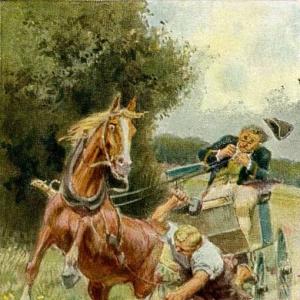Reading time: 5 min
There was once a King’s son who went out into the world, and he was full of thought and sad. He looked at the sky, which was so beautifully pure and blue, then he sighed, and said, „How well must all be with one up there in heaven!“ Then he saw a poor gray-haired man who was coming along the road towards him, and he spoke to him, and asked, „How can I get to heaven?“ The man answered, „By poverty and humility. Put on my ragged clothes, wander about the world for seven years, and get to know what misery is, take no money, but if thou art hungry ask compassionate hearts for a bit of bread. In this way thou wilt reach heaven.“
Then the King’s son took off his magnificent coat, and wore in its place the beggar’s garment, went out into the wide world, and suffered great misery. He took nothing but a little food, said nothing, but prayed to the Lord to take him into his heaven. When the seven years were over, he returned to his father’s palace, but no one recognized him. He said to the servants, „Go and tell my parents that I have come back again.“ But the servants did not believe it, and laughed and left him standing there. Then said he, „Go and tell it to my brothers that they may come down, for I should so like to see them again.“ The servants would not do that either, but at last one of them went, and told it to the King’s children, but these did not believe it, and did not trouble themselves about it. Then he wrote a letter to his mother, and described to her all his misery, but he did not say that he was her son. So, out of pity, the Queen had a place under the stairs assigned to him, and food taken to him daily by two servants. But one of them was ill-natured and said, „Why should the beggar have the good food?“ and kept it for himself, or gave it to the dogs, and took the weak, wasted-away beggar nothing but water. The other, however, was honest, and took the beggar what was sent to him. It was little, but he could live on it for a while, and all the time he was quite patient, but he grew continually weaker. As, however, his illness increased, he desired to receive the last sacrament. When the host was being elevated down below, all the bells in the town and neighbourhood began to ring. After mass the priest went to the poor man under the stairs, and there he lay dead. In one hand he had a rose, in the other a lily, and beside him was a paper in which was written his history.
When he was buried, a rose grew on one side of his grave, and a lily on the other.
 Learn languages. Double-tap on a word.Learn languages in context with Childstories.org and Deepl.com.
Learn languages. Double-tap on a word.Learn languages in context with Childstories.org and Deepl.com.Backgrounds
Interpretations
Adaptions
Summary
Linguistics
„Poverty and Humility Lead to Heaven“ is a German fairy tale collected and published by the Brothers Grimm, Jacob and Wilhelm, in their famous collection „Children’s and Household Tales“ („Kinder- und Hausmärchen“), first published in 1812. The Brothers Grimm were well-known German cultural researchers, linguists, and authors who dedicated their lives to collecting and documenting folklore, ultimately preserving a rich cultural heritage.
The story itself is based on European folklore, drawing on themes and motifs that are present in many other tales of the time. „Poverty and Humility Lead to Heaven“ is one of many stories where protagonists undertake challenging journeys, often driven by a moral or spiritual purpose, in order to achieve their goals.
The Brothers Grimm compiled and published their collection of fairy tales during the early 19th century in Germany, a time of rapid industrialization and political change. During this period, there was a growing interest in national identity and cultural heritage. The collection of stories, including „Poverty and Humility Lead to Heaven,“ became popular not only in Germany but also in other parts of Europe and around the world.
While many fairy tales by the Brothers Grimm contain elements of fantasy and magic, „Poverty and Humility Lead to Heaven“ has a more grounded approach, focusing on themes of humility, self-sacrifice, and spiritual growth. This story, like others in their collection, has remained popular for generations due to its universal themes, timeless message, and the Brothers Grimm’s dedication to preserving traditional folklore.
„Poverty and Humility Lead to Heaven“ is a fairy tale with multiple layers of interpretation, highlighting themes such as self-sacrifice, the value of humility, the human struggle, and divine providence.
Self-sacrifice: The King’s son willingly gives up his privileged life to seek entry into heaven. He takes on the hardships and sufferings of a beggar to gain spiritual insight, showing the importance of personal sacrifice in the quest for spiritual growth and fulfillment.
The value of humility: The story emphasizes the importance of humility, as the prince sheds his royal identity and status to live as a beggar. This change allows him to empathize with the less fortunate and experience life from a different perspective, ultimately teaching him to value the virtues of humility and compassion.
The human struggle: The tale depicts the struggles faced by the prince during his seven-year journey, showing that even those from privileged backgrounds can face hardships. The story illustrates the universal nature of human suffering and the potential for personal growth through adversity.
Divine providence: The miraculous ringing of the bells during the prince’s last sacrament and the appearance of the rose and the lily at his grave symbolize divine intervention and approval of his humble and selfless journey. These events suggest that his sacrifices were acknowledged and rewarded by a higher power, reinforcing the importance of maintaining faith and devotion in difficult times.
Overall, the fairy tale „Poverty and Humility Lead to Heaven“ conveys a message of spiritual growth and enlightenment through self-sacrifice, humility, and empathy. The story encourages readers to embrace hardships, learn from adversity, and maintain faith in the face of suffering in order to find personal fulfillment and divine grace.
The fairy tale „Poverty and Humility Lead to Heaven“ has been adapted in various forms over the years, including in literature, film, and theater. Here are a few notable adaptations:
„The Poor Man and the Rich Man“ (1854) by Hans Christian Andersen: This is a retelling of the Grimm Brothers‘ story by the Danish author Hans Christian Andersen. It features a similar plot but with different characters and settings.
„The Good Person of Szechwan“ (1943) by Bertolt Brecht: This play by German playwright Bertolt Brecht is loosely based on the Grimm Brothers‘ story. It follows the character of Shen Te, a poor woman who is rewarded for her generosity, but who also struggles with the challenges of living in a society that values wealth and power.
„The Little Match Girl“ (1845) by Hans Christian Andersen: Although not a direct adaptation of the Grimm Brothers‘ story, this famous tale by Andersen shares similar themes of poverty and suffering, and the importance of compassion and empathy.
„The Beggar’s Opera“ (1728) by John Gay: This satirical musical play is not a direct adaptation of the Grimm Brothers‘ story, but it does explore similar themes of poverty, wealth, and morality. It features a cast of characters from the lower classes of society and critiques the moral values of the upper classes.
„The Princess and the Beggar“ (2010) by Linda Crew: This is a children’s book that is a modern retelling of the Grimm Brothers‘ story. It features a young princess who disguises herself as a beggar to learn more about the lives of the poor and needy, and who ultimately learns the value of humility and compassion.
„The Rich Man and the Shoemaker“ (2007) by Jillian Powell: This is another children’s book that is a modern retelling of the Grimm Brothers‘ story, with updated settings and characters. It follows the story of a wealthy businessman and a poor shoemaker, and emphasizes the importance of kindness and generosity.
„Poverty and Humility Lead to Heaven“ is a fairy tale by the Brothers Grimm that tells the story of a sad and thoughtful King’s son who longs to know how to reach heaven. One day, he meets a poor, gray-haired man who advises him that the way to heaven is through poverty and humility. The man instructs the prince to wear his ragged clothes, wander the world for seven years, experience misery, and rely on the compassion of others for sustenance. In this way, the prince would reach heaven.
Following the man’s advice, the King’s son exchanges his royal garments for the beggar’s clothes and embarks on a seven-year journey. He endures great hardship and relies solely on the kindness of others for his survival, all the while praying for entry into heaven. Once the seven years pass, he returns to his father’s palace, but no one recognizes him.
Despite his attempts to inform his family of his return, the servants dismiss him, and his siblings pay him no attention. Eventually, he writes a letter to his mother detailing his sufferings but not revealing his identity. The sympathetic Queen assigns him a place under the stairs and orders food to be delivered to him daily by two servants. However, one servant is cruel and keeps the food for himself or gives it to dogs, while the other is kind and delivers what little sustenance he can to the beggar.
As the prince’s health deteriorates, he requests the last sacrament. When it is performed, bells from all over the town and its surroundings miraculously ring. The priest finds him dead, holding a rose in one hand, a lily in the other, and a paper detailing his story nearby. Upon his burial, a rose and a lily grow on either side of his grave, symbolizing his journey of poverty and humility that ultimately led him to heaven.
The Brothers Grimm’s fairy tale „Poverty and Humility Lead to Heaven“ offers a linguistically rich narrative that explores themes of humility, transformation, and spiritual enlightenment. The story’s language plays a crucial role in conveying its moral and emotional layers.
Narrative Structure and Style: The tale follows a simple, linear progression typical of fairy tales, where events unfold in a straightforward cause-and-effect manner. The language is formal and somewhat archaic, reflecting the story’s historic roots and timeless moral lesson. Words like „wilt“ and „thou“ imbue the narrative with a sense of reverence and gravity.
Character Dialogue: Direct dialogue is used sparingly but effectively. The conversations are concise and laden with meaning, driving the plot forward while illustrating character traits. The King’s son begins with a self-reflective question, „How can I get to heaven?“ signaling his internal conflict and existential quest. The response from the gray-haired man, „By poverty and humility,“ serves as the story’s thematic cornerstone.
Symbolism: Clothing symbolizes transformation and identity. The prince’s exchange of his „magnificent coat“ for the „beggar’s garment“ represents his deliberate move towards humility and the shedding of worldly status. The rose and the lily in the prince’s hands at death symbolize purity and martyrdom. Their growth on his grave signifies the eternal life and reward promised through spiritual devotion.
Imagery: Vivid descriptions, such as the „poor gray-haired man“ and „ragged clothes,“ evoke empathy and a sense of shared human experience. The imagery of the sky being „beautifully pure and blue“ contrasts with the prince’s internal sadness, highlighting his desire for spiritual transcendence.
Themes of Poverty and Humility: The language underscores these central themes through repeated mentions of beggars, food scarcity, and the prince’s persistent patience and suffering. The humility of the prince is emphasized in his silent endurance and lack of demand or assertion of his royal identity.
Motif of Recognition and Misrecognition: This motif is linguistically embedded in the repeated instances where the transformed prince is unrecognized by his own family, underscoring themes of true identity versus perceived status. The tale uses phrases such as „no one recognized him,“ emphasizing the outer transformation and the internal realization of self-worth and humility.
Moral & Philosophical Undertones: The narrative’s linguistic simplicity mirrors the moral simplicity: through suffering and humility, enlightenment and salvation are attained. A spiritual reward is linguistically prefigured through sacred references, such as the „last sacrament,“ culminating in the prince’s peaceful death and symbolic transformation.
Conclusion
The language in „Poverty and Humility Lead to Heaven“ is not just a vehicle for storytelling but a deliberate construct that deepens the narrative’s moral and emotional resonance. Through careful selection of words, imagery, and dialogue, the Brothers Grimm effectively convey themes of sacrifice, redemption, and the eternal benefits of a humble spirit.
Information for scientific analysis
Fairy tale statistics | Value |
|---|---|
| Number | KHM 204 |
| Translations | DE, EN |
| Readability Index by Björnsson | 30.3 |
| Flesch-Reading-Ease Index | 79.9 |
| Flesch–Kincaid Grade-Level | 7.2 |
| Gunning Fog Index | 9.6 |
| Coleman–Liau Index | 7 |
| SMOG Index | 8.1 |
| Automated Readability Index | 7.1 |
| Character Count | 2.514 |
| Letter Count | 1.916 |
| Sentence Count | 24 |
| Word Count | 495 |
| Average Words per Sentence | 20,63 |
| Words with more than 6 letters | 48 |
| Percentage of long words | 9.7% |
| Number of Syllables | 620 |
| Average Syllables per Word | 1,25 |
| Words with three Syllables | 17 |
| Percentage Words with three Syllables | 3.4% |

 Facebook
Facebook  Whatsapp
Whatsapp  Messenger
Messenger  Telegram
Telegram Reddit
Reddit













